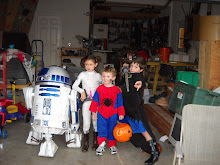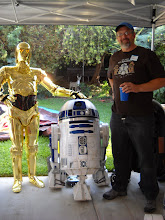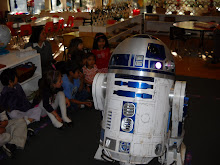Jamie McShan and I were talking about painting on email and I realized that this would be a good blog post.
Jamie's blog. By the way, his MDF horseshoe ideas and his periscope lifter are brilliant. Check out his work.
The topic: painting parts with both blue and silver. That would be the booster covers, the ankle details, the octagon ports, the power coupler ports, the radar eye, the side body panels, and the coin slots. Here’s the rough summary of what I’ve done so far.
When I built them, I attached the ankle cylinders and the ankle holders together before I put them on the droid. Then I painted them as a unit. I primed the unit, then I masked off the blue sections to paint the silver and then masked the silver to paint the blue. That worked out well.
I haven't painted the interior silver details on the Radar Eye yet, and I'm not sure if I'm going to. At this point, I don't think even the best quality job I could do on that would look better than just leaving it alone, if you know what I mean. Getting smooth, even silver paint in there is too tricky.
On the octagon ports, I found a clever solution suggested by someone on the groups. Mine are resin. So I took them and carefully sanded the backs off of them on my big stationary belt sander. I sanded them down just until the back was off and up to the bottom edge of the recessed details inside. Look into the octagon ports and you'll see what I mean. Once that was off, I painted the whole port silver. Then I made up some pieces of styrene to fit on the back and I painted those R2 Blue. Then I just glued that back plate back on and I had perfect blue and silver lines on the details. The problem here is that I have since figured out that the sidewalls of the octagon ports are also blue. I don't like the way that looks, but it's clear in the movie pictures. I've already installed my ports, but I think the way to deal with this would be to cut the back off of the port altogether right where the sidewall meets the backwall, and then paint them separately. Don't know how that would work with the sanding trick too. That's one of the details I'll get back to later. I wanted a good tight fit on my ports, so I glued them all in, and now I can't take them out easily.
On the power coupler ports, it's a different matter. I originally painted them all silver, then I used a paint brush to put blue (from the spray can) onto the raised triangle details inside. The spray paint isn't made for this, obviously, and it gummed up on my and didn't come out very well. The color and coat on those triangles is uneven. I think I'll go back to that and do some very careful surgical masking and try to paint them again. But masking like that with tape doesn't work in tight details. Some always seeps under the edge and you don't get clean lines, with one exception:
Side body port panels. These are all silver and blue too. I think that some people are making as single blue backing plate and then painting these before they are assembled. That's a good workable solution. I built my body ports (the ones with the vertical recessed slots), painted them silver, and then I masked off the fronts of them. I covered them with tape and then used an xacto with a sharp new blade to carefully remove the tape over the recesses where blue paint needs to get in. Then I painted them blue. I did a couple of pretty light coats, hitting them from an angle so that the blue paint could get down in there. Then I removed the masking almost immediately to get clean lines. That worked well and I got good results.
On the coin slots I painted them silver first, then I carefully masked off the front faces of the 6 little units. Then I painted the rest blue. That came out pretty well.
The ankle details were tricky. Getting a clean line between blue and silver on those tabs on top was hard. I painted them one color, then masked and painted the other color. Then I think I did a bit of touch up with a paint brush. Close inspection of all of these would reveal my crappy work, but from anything over 5 feet away, it's not visible.
I haven’t done the booster covers yet, but I think the best way to do the recessed silver pockets will be to mask off the blue now that they’ve been painted and cured, and then cut out the masking tape over the slots with a sharp xacto knife and paint the pockets silver with spray paint. I’ve been using Rustoleum Metallic Silver, by the way. It seems to have the most aluminum looking results in my tests.
So I guess the lessons I learned were: 1. figure out the best order to paint in--either silver first then blue, or vice versa, depending on the nature of the details, the curves, angles and features. 2. Paint the first color carefully --see all the lessons I learned about painting on the blog. Let it dry thoroughly. 3. spend some time carefully masking off the first coat as prep for the next color. 4. Paint the second color, remove masking soon to prevent paint damage, sticking, and to get clean lines. 5. Where possible, cut or take apart the pieces along blue/silver lines for separate painting.






































